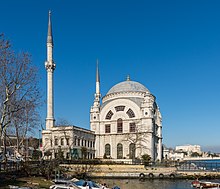Dolmabahçe Mosque
| Dolmabahçe Mosque | |
|---|---|
 | |
| Religion | |
| Affiliation | Islam |
| Location | |
| Location | Istanbul, Turkey |
| Geographic coordinates | 41°02′12.22″N 28°59′43.04″E / 41.0367278°N 28.9952889°E |
| Architecture | |
| Architect(s) | Garabet Balyan |
| Type | Mosque |
| Style | Ottoman architecture |
| Groundbreaking | 1853 |
| Completed | 1855 |
| Specifications | |
| Minaret(s) | 2 |
| Minaret height | 40.25 metres (132.05 feet)[1] |
The Dolmabahçe Mosque is a baroque waterside
The mosque has twin minarets and is distinguished by the huge stone arches on its facades which are cut with large windows, allowing light to flood the interior.
From 1956 to 1960 the mosque provided a venue for the
Background
In the 19th century, the
Features
The building is situated on the shores of the Bosphorus, making the location strategic and unique to visitors. A huge dome crowns the main prayer hall, while there are two tall minarets on the rear building sitting right behind the dome symmetrically. The exterior walls have many transparent glass windows that allow for the penetration of sunlight and ventilation due to the huge size of the building and its intended large capacity. Overall, the baroque style of architecture gives the building an exceptionally ornamental aesthetic that attracts utmost attention even from a distance. A closer look at the interior of the building is even mind-boggling with beautiful Arabic calligraphy on the walls and various symmetrical shapes in gold. At the center of the calligraphy are the two most inspiring Islamic themes “Allah, subhanahu wa ta'ala” and “Mohammad, sallallahu alaihi wasallam” in yellow text and green background. The ceiling is decorated with floral designs and a huge sparkling chandelier hangs right in the center. The marble floor is covered with carpets for the purpose of prayers.
Withstanding seismic activities
Over the years, Dolmabahçe Mosque has withstood several seismic activities. Professor Ahmet Murat Turk (PhD. Civil Engineering) of Istanbul Kultur University and Cumhur Cosgun (PhD. Structural Engineering) of Istanbul Kultur University in their book “Seismic behaviour and Retrofit of Historic Masonry Minaret”, analyzed the dynamic behavior of the block masonry minaret of Dolmabahçe Mosque. The Ottoman Empire was in a region with high seismicity and therefore the minarets of Dolmabahce Mosque are vulnerable. To an extent, Ottoman historical masonry put seismic factors into consideration when designing and building houses and monuments such as Dolmabahçe Mosque. Indeed, despite the elegant architecture, the west side minaret has encountered damages due to seismic activities in the region and has recently been restored.
Significance

Dolmabahce Palace was home to the Ottoman crown and the official residence of the Sultan. Dolmabahce Mosque thus served as the official mosque of the palace making it an important monument in the Ottoman Empire due to its proximity. It also served as mosque for ‘Salat al-Jumuah’ (Friday prayer mosque) as well as prayer grounds for foreign dignitaries and ambassadors from other parts of the Muslim world who visited the Sultan. Dolmabahçe Mosque, besides being a place for prayer, also uplifts the image of the Sultan among Arabs Muslims and Persians as a devoted Muslim who was willing to strive in Jihad by sacrificing his wealth for the course of Islam.
Gallery
-
Interior of the Dolmabahçe Mosque
-
Detail of the mihrab of Dolmabahçe Mosque
-
The Dome in the Dolmabahçe Mosque
-
The mihrab at Dolmabahçe Mosque
-
View of the Dolmabahçe Mosque from sea
-
Dolmabahçe Mosque from Bosporus
-
Dolmabahçe Mosque from nearby harbour
-
Dolmabahçe Mosque from west
-
Dolmabahçe Mosque interior view towards entrance
-
Dolmabahçe Mosque top of mihrab
-
Dolmabahçe Mosque kürsü
-
The Mosque in 1963. Picture taken from the sea by mediterranean sea traveler och writer Göran Schildt.
See also
References
- ^ Structural Studies, Repairs and Maintenance of Heritage, C. A. Brebbia,L. Binda, page 437
- ArchNet.org. "General information on Dolmabahçe Mosque". Archived from the original on 2012-05-03. Retrieved 2009-03-06.
External links
- Images of the Dolmabahçe Mosque
- History of Dolmabahce Mosque
- "Seismic Behaviour and Retrofit of Historic Masonry Minaret". Journal of the Croatian Association of Civil Engineers. 64: 39–45. 2012. .
- Turk, Ahmet Murat (2013). "Seismic Response Analysis of Masonry Minaret and Possible Strengthening by Fiber Reinforced Cementitious Matrix (FRCM) Materials". Advances in Materials Science and Engineering. 2013: 1–14. .
- Profile of Ahmet Murat Turk
- Profile of Cumhur Cosgun












